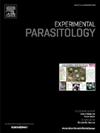菊花异黄酮体外和体内杀利什曼虫和锥虫活性的研究G.尼科尔森木材副产品。
IF 1.6
4区 医学
Q3 PARASITOLOGY
引用次数: 0
摘要
皮肤利什曼病和恰加斯病是被忽视的热带病,影响着全世界数百万人。尽管与这些感染相关的发病率很高,但目前的治疗方法往往是高毒性的,而且疗效正在减弱。因此,迫切需要新的治疗方案。在本研究中,对菊花(“guayacán”)木屑进行了生物导向测定,以鉴定有前景的生物活性化合物。对乙醇粗提物、5个层析组分、纯异黄酮和烟叶醇及其混合物进行体外抗巴西利什曼原虫和克氏锥虫试验。粗提物、富含麻黄素和前叶草醇的F2馏分和两种纯异黄酮具有较高的杀利什曼尼虫和锥虫活性。考虑到异黄酮混合物的丰富性和易得性,进一步在感染巴西乳杆菌的仓鼠和感染克氏t型虫的小鼠体内评估其治疗潜力。值得注意的是,外用和腹腔注射该色谱组分可使感染巴西乳杆菌的仓鼠的临床治愈率达到67%,并使感染克氏锥虫的小鼠的寄生虫率降低75%。虽然某些类黄酮的抗寄生虫作用已经被记录下来,但这项研究是第一次在动物模型中证明异黄酮对这两种疾病的功效。对克氏T. cruzi和巴西L. brasiliensis这两种治疗方案有限且现有治疗方案存在显著缺陷的病原体所观察到的潜在疗效,突出了从木材工业废料中提取的sativan和vestitol的组合治疗潜力,为进一步开发提供了丰富和可获得的来源。本文章由计算机程序翻译,如有差异,请以英文原文为准。

In vitro and in vivo leishmanicidal and trypanocidal activities of isoflavans from Tabebuia chrysantha (Jacq.) G. Nicholson timber by-products
Cutaneous Leishmaniasis and Chagas disease are neglected tropical diseases that affect millions worldwide. Despite the high morbidity associated with these infections, current treatments are often highly toxic and are showing diminishing efficacy. Thus, new therapeutic options are urgently needed. In this study, bio-guided assays were conducted on the sawdust of Tabebuia chrysantha ("guayacán") to identify promising bioactive compounds. The ethanolic crude extract, five chromatography fractions, pure isoflavans sativan and vestitol, and a mixture were evaluated in vitro against Leishmania braziliensis and Trypanosoma cruzi. High leishmanicidal and trypanocidal activities were observed in the crude extract, fraction F2 (rich in sativan and vestitol), and the two pure isoflavans. Given the abundance and ease of obtaining the isoflavan mixture, its therapeutic potential was further evaluated in vivo in hamsters infected with L. braziliensis and mice infected with T. cruzi. Remarkably, topical and intraperitoneal administration of the chromatography fraction achieved a 67% clinical cure in hamsters with L. braziliensis infection and a 75% reduction in parasitemia in T. cruzi-infected mice. While the antiparasitic effects of certain flavonoids have been documented, this study is the first to demonstrate the efficacy of isoflavans in animal models for both diseases. The potential efficacy observed against T. cruzi and L. braziliensis, two pathogens with limited treatment options and a significant drawback of the available treatments, highlights the therapeutic potential of this combination of sativan and vestitol, which can be derived from timber industry waste, presenting an abundant and accessible source for further development.
求助全文
通过发布文献求助,成功后即可免费获取论文全文。
去求助
来源期刊

Experimental parasitology
医学-寄生虫学
CiteScore
3.10
自引率
4.80%
发文量
160
审稿时长
3 months
期刊介绍:
Experimental Parasitology emphasizes modern approaches to parasitology, including molecular biology and immunology. The journal features original research papers on the physiological, metabolic, immunologic, biochemical, nutritional, and chemotherapeutic aspects of parasites and host-parasite relationships.
 求助内容:
求助内容: 应助结果提醒方式:
应助结果提醒方式:


